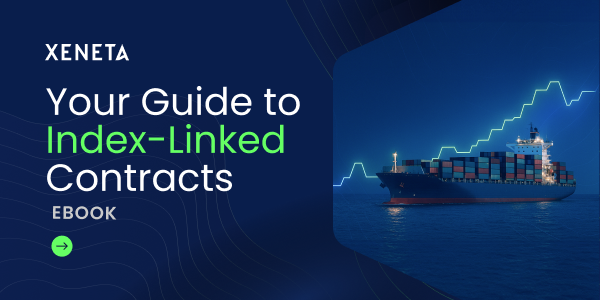Wild rate swings and market uncertainty have made it harder for shippers and carriers to stay aligned. With both sides struggling to predict what’s next, friction during contract negotiations and contract fulfilment is at an all-time high.
In fact, it's precisely this disconnect between fixed-rate contracts and real-time market conditions that raises questions around contract enforceability – opening the door to opportunistic behavior and leaving some BCOs feeling ill-equipped to renegotiate with confidence.
This leaves many across the industry asking the same question: how do we take the tension out of contracts when the spot market surges as much as six-fold during a contractual term – dramatically higher than their baseline levels. This exposure can manifest in overpaying for cargo or not getting allocation for the shippers. In addition, the effort to sign these contracts are high but the resulting outcome doesn't compensate for the efforts and shippers often spend even more time renegotiating.
So how do we take the tension out of tenders and build longer-term relationships that flex with the market – not against it?
One answer gaining traction is a move away from rigid, annual fixed-rate contracts, and a renewed focus on index-linked long-term agreements that flex with the market, irrespective of the level of volatility.
And it’s not just theory.
In the latest episode of The Freight Debate podcast, Rajesh Bhol, Principal Product Manager at Xeneta spoke to two industry heavyweights: Christian Pedersen, Global Head of Ocean Contract Products at Maersk, and Patrik Berglund, CEO and Co-Founder of Xeneta. Listen now to hear their full discussion about the growing interest in index-linked contacts from both carriers and shippers – or read on for the highlights.
“Friction between the buyer and the seller prohibits long term partnerships and long-term thinking, and it drives very transactional behavior on both sides.”
Patrik Berglund, CEO and Co-Founder of Xeneta
We’re consistently being let down by broken contracts
While fixed-rate contracts offer the illusion of security and predictability, in practice they’re often not fully enforceable. When market conditions shift, either BCOs or carriers may walk away. This can look like carriers pulling allocations in tight markets to chase higher spot rates or BCOs shifting volumes when spot rates crash. This widely accepted practice has created a cycle of broken expectations, strained relationships, and missed shipments on both sides.
“Shippers need to predict both demands and whether they’re actually going to get the space they bought from carriers at the rate they bought it. It's a natural behavior that if you’ve already burned your fingers, the next time you're going to make sure you get back the money you might have lost. You're going to make sure you buy more space than you may need, because you at least want to have some buffer to cover those things. But that just exaggerates that vicious cycle when you don’t fulfil it.”
Christian Pedersen, Global Head of Ocean Contract Products at Maersk
If customers are overbooking space and not filling it, carriers will start to see them as unreliable. And as power dynamics change in line with market shifts this will create a lack of trust and tension on both sides of the relationship.
“I find it hard to find any other commodity of this size that is dealt with in such an immature way… And I think more and more parties, companies, shippers, forwarders, carriers, are realizing that there's got to be a better way.”
Patrik Berglund, CEO and Co-Founder of Xeneta
This issue was also front and center at the 2024 Xeneta Summit, where Erik Devetak (Chief Technology & Data Officer, Xeneta), Sami Nazar (Category Manager International, Decathlon), and Bjorn Vang Jensen (Founder & CEO, Nanook Management Consultancies) explored how index-linked contracts could offer a more sustainable path forward for ocean freight procurement.
The market has changed, and contracts need to change too
Before Covid, longer contracts were seen as better contracts, with some partnerships looking at options for up to five years. Now, of course, that’s all changed. While BCO Shippers still operate with 12-month contract validity on their tenders contracts, three- and six-month contracts have grown in popularity. Shorter cycles reduce the risk of locking into unfavorable rates, but frequent renegotiations demand time, resources, and internal alignment — creating new strains in already volatile conditions.
Index-linked contracts, on the other hand, tie rates to a market index so they can automatically adjust to real-time conditions. They remove the need for constant renegotiations and make sure whenever the market moves, you can move with it.
Yes, it can be tempting to view rate negotiations as simply a race to the most favorable price. But if the market moves, you could lose your entire contract. It’s important to consider long-term value and make sure you can keep service and delivery consistent during market shifts.
“What is a perfect index? It’s one that represents the actual loaded spot rate in this week, with as little to no lag as possible. That's perfect because then you can start saying what is the real market rate of getting on the ship today, and on that basis, you can start delivering.”
Christian Pedersen, Global Head of Ocean Contract Products at Maersk
If index-linked contracts are such a silver bullet, why hasn’t the whole industry adopted them?
It’s a fair question. Especially given the promise of longer-term partnerships, predictable pricing, and less friction during volatile periods. But adoption hasn’t taken off across the board yet, and there are a few key reasons why.
Firstly, many shippers and freight forwarders lack the education and experience needed to design and manage these contracts without creating extra operational complexity. Second, there’s currently no universal framework or standardization for index-linked agreements. That makes it difficult for both parties to evaluate and compare offers, and to trust that the terms are genuinely balanced.
Without a shared structure and clearer understanding, hesitation persists. Even when the market conditions are ideal for change, inertia and uncertainty can keep both sides locked in outdated ways of working.
How can we make index-linked contracts work for everyone?
According to Pedersen, some of the objections he's heard around index-linked contracts centers on concerns about transparency and the commoditization of carrier services. Some shippers believe they already outperform the market – either due to their volume leverage or close carrier relationships – and see added transparency as unnecessary. On the carrier side, those offering differentiated services fear being lumped in with commoditized offerings.
But Xeneta and Maersk’s position is clear: "transparency will benefit the industry." Pedersen points out that neither side consistently outperforms the market through timing or trading alone. In fact, many case studies suggest that improving transparency not only increases value but also drives efficiency across the industry. With a clear market index, carriers can confidently position themselves relative to the index, highlighting the distinct value they bring — rather than being diminished by it.
There are some practical challenges for index-linked contracts that also need to be addressed.
“We have some structural challenges in the industry, which is around building transparency and avoiding commoditization of the products. But then there are some practical and more tactical challenges too. ‘How do I build a contract?’, ‘How do I know that I'm building a right contract?’, ‘And how do we operationalize this?”
Rajesh Bhol, Principal Product Manager at Xeneta
Structuring an index deal can be complicated. This type of contract is still relatively new to the industry and there’s not yet any real standardization in place to simplify the process. The most crucial elements to a good index-linked contract are high quality indices and simple processes for filing rate adjustments. There is still work to be done, but the industry is moving in the right direction.
“If we created a standard, the benefits and rewards from having clean, standardized data across all the all carriers and BCOs would create immense of operational efficiency gains.”
Patrik Berglund, CEO and Co-Founder of Xeneta
At the end of the day, shippers and carriers have the same mission: to get cargo shipped from A to B as required and as expected. So, working together is the best way to create positive changes in the industry and standardize ways of working that benefit every party.
Stay up to date with The Freight Debate
Tune in to the full conversation with Rajesh, Patrik, and Christian for a deeper dive into the growing interest in index-linked contracts from both shippers and carriers.
And remember to subscribe to The Freight Debate on your favorite podcast platform to stay ahead of the curve on market trends, insights, and the shifts that could shape your strategy.
You can find us on YouTube, Apple Music and Spotify.
%201.png)






.png?width=860&height=311&name=Indexing%20Banner%20(7).png)


